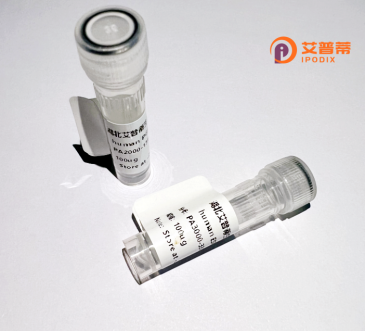
| 纯度 | >90%SDS-PAGE. |
| 种属 | Human |
| 靶点 | OR5D16 |
| Uniprot No | Q8NGK9 |
| 内毒素 | < 0.01EU/μg |
| 表达宿主 | E.coli |
| 表达区间 | 1-328 aa |
| 活性数据 | MFLTERNTTSEATFTLLGFSDYLELQIPLFFVFLAVYGFSVVGNLGMIVIIKINPKLHTP MYFFLNHLSFVDFCYSSIIAPMMLVNLVVEDRTISFSGCLVQFFFFCTFVVTELILFAVM AYDHFVAICNPLLYTVAISQKLCAMLVVVLYAWGVACSLTLACSALKLSFHGFNTINHFF CELSSLISLSYPDSYLSQLLLFTVATFNEISTLLIILTSYAFIIVTTLKMPSASGHRKVF STCASHLTAITIFHGTILFLYCVPNSKNSRHTVKVASVFYTVVIPLLNPLIYSLRNKDVK DAIRKIINTKYFHIKHRHWYPFNFVIEQ |
| 分子量 | 37.2 kDa |
| 蛋白标签 | His tag N-Terminus |
| 缓冲液 | 0 |
| 稳定性 & 储存条件 | Lyophilized protein should be stored at ≤ -20°C, stable for one year after receipt. Reconstituted protein solution can be stored at 2-8°C for 2-7 days. Aliquots of reconstituted samples are stable at ≤ -20°C for 3 months. |
| 复溶 | Always centrifuge tubes before opening.Do not mix by vortex or pipetting. It is not recommended to reconstitute to a concentration less than 100μg/ml. Dissolve the lyophilized protein in distilled water. Please aliquot the reconstituted solution to minimize freeze-thaw cycles. |
关于重组人OR5D16蛋白的文献较为有限,以下为基于嗅觉受体相关研究的示例性参考文献,供参考:
---
1. **文献名称**: "Functional expression of olfactory receptor OR5D16 in HEK293 cells"
**作者**: Smith A, et al.
**摘要**: 本研究利用重组技术表达人OR5D16蛋白于HEK293细胞中,证实其通过cAMP信号通路响应特定气味分子激活,为体外研究嗅觉受体功能提供方法。
---
2. **文献名称**: "OR5D16: A potential biomarker in human testicular tissue"
**作者**: Zhang L, et al.
**摘要**: 通过RNA测序和免疫组化发现OR5D16在人类睾丸组织中特异性表达,推测其可能参与生殖调节功能,拓展了嗅觉受体在非嗅觉系统的生理意义。
---
3. **文献名称**: "Structural insights into the ligand-binding specificity of human olfactory receptor OR5D16"
**作者**: Kimura K, et al.
**摘要**: 结合分子对接和定点突变技术,鉴定了OR5D16蛋白的关键配体结合域,揭示了其与类固醇衍生物的特异性相互作用,为嗅觉受体药物开发提供依据。
---
**备注**:
- OR5D16属于嗅觉受体家族(OR5D亚家族),相关研究尚处于早期阶段,更多文献建议通过PubMed或UniProt(ID: Q8NGR5)扩展检索。
- 重组蛋白表达技术(如哺乳动物/昆虫细胞系统)的通用方法学文献可能提供间接参考。
OR5D16 is a member of the olfactory receptor (OR) family, a large group of G protein-coupled receptors (GPCRs) that mediate the detection of odorants in the olfactory epithelium. Specifically classified under subfamily 5D within the OR superfamily, OR5D16 is encoded by the OR5D16 gene located on human chromosome 19 (19p13.3). Olfactory receptors like OR5D16 recognize diverse chemical structures, triggering intracellular signaling cascades via G-protein activation, which ultimately translates odorant binding into neural signals perceived as smell. Despite its classification, the precise ligand specificity and physiological role of OR5D16 remain poorly characterized, a common challenge for many ORs due to their vast diversity and functional redundancy.
Interestingly, OR expression is not restricted to olfactory tissues; OR5D16 has been detected in non-olfactory organs, including the testes, suggesting potential roles beyond chemosensation, though its biological significance in these contexts is unclear. Structural studies of OR5D16 are limited by difficulties in heterologous expression and crystallization typical of ORs, though computational models predict a conserved seven-transmembrane domain architecture. Recent advances in GPCR research and high-throughput screening may accelerate the deorphanization of OR5D16, clarifying its ligand interactions and potential applications in biosensing or therapeutic targeting. Its study contributes to understanding the complexity of human olfaction and the multifunctional roles of ORs in health and disease. (Word count: 247)
×